Google Alerts Alternatives: A Detailed Comparison for 2026
Table of contents
Monitoring online conversations has never been more complex, or more important. If you’re still relying only on Google Alerts, you’re probably missing most real-time social media mentions, emotional context, crisis signals, and influencer activity.
In this article, I break down the top Google Alerts alternatives for 2026, show where Google Alerts still helps, and where it falls short. Plus, it gives you a practical, expert-guided overview of tools worth trying this year.
Let’s dive in.
Best Google Alerts alternatives:
1. Brand24 – includes AI insights, sentiment analysis, LLM monitoring, crisis alerts, and full social + web coverage.
2. Sprout Social – Best for brands needing social media management combined with listening and analytics.
3. Talkwalker / Talkwalker Alerts – Talkwalker Alerts is the best free Google Alerts replacement; the full suite is powerful for enterprise analytics.
4. Mention – Strong for real-time monitoring across social and web, with in-app responding.
5. Meltwater – Media intelligence with broad source coverage (web, social, and print, but no LLM).
6. Awario – Affordable option with sentiment analysis and multilingual tracking.
7. Sprinklr – Listening and customer intelligence across social + web.
8. Keyhole – Social-first tool with hashtag analytics, campaigns, and influencer insights.
Top Google Alerts alternatives:
01 Brand24
Brand24 is an AI-powered social listening and media monitoring platform that tracks brand mentions across social media platforms, news sites, blogs, review sites, podcasts, newsletters, and even LLMs like ChatGPT and Gemini.
Unlike Google Alerts, Brand24 gives real-time alerts, sentiment analysis, emotional insights, conversation context, influencer scores, and historical data.
Key features:
- Real-time monitoring of online mentions
- AI-based insights and analysis
- LLM Monitoring
- Social media influencer detection
- Alerts and reporting
- AI Topic Analysis
- Context search to exclude irrelevant mentions
- Boolean search for precise analysis
Monitored sources:
- Social media sites (Facebook, Instagram, X/Twitter, TikTok, YouTube, LinkedIn, Reddit)
- News sites
- Blogs
- Forums
- Podcasts
- Google Reviews, App Store, Trustpilot, Yelp
- Web pages & comment sections
- LLMs (ChatGPT, Perplexity, Gemini, Claude)
Best for:
- Mid to large-sized businesses
- Enterprises
- PR professionals
- Social media & community teams
Strengths:
- One of the most complete social listening tools on the market, with great filtering and reporting options.
- Real-time tracking mentions, not delayed like Google Alerts.
- AI-powered platform – lots of ready-to-use insights based on your data.
What could be better:
- Access up to 30 days of historical data before the project’s setup.
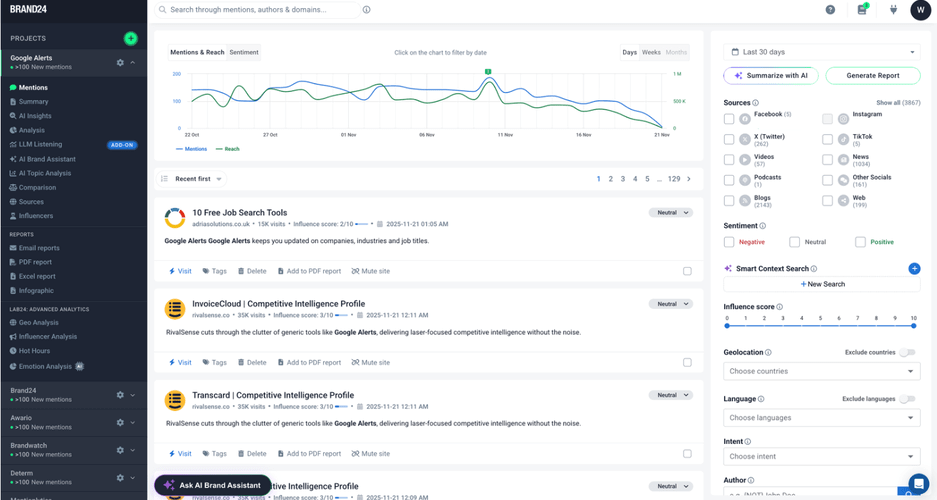
Comparison: Google Alerts vs. Brand24
| Category | GA | Brand24 |
|---|---|---|
| Real-time monitoring | ❌ delayed | ✅ yes |
| Platforms covered | Full coverage | |
| Sentiment analysis | ❌ none | ✅ AI-powered |
| Influencer detection | ❌ none | ✅ yes |
| LLM monitoring | ❌ none | ✅ yes |
| Noise filtering | ❌ weak | ✅ strong |
| Reporting | ❌ none | ✅ customizable |
| Best for | individuals | SMBs → enterprises |
GA is definitely more popular – got over 3,8K mentions during the last 30 days.
But the mentions it got were less favorable than Brand24’s. It’s an alternative that wins in terms of both a high number of positive and a low number of bad mentions.

02 Sprout Social
Sprout Social is best known as a social media management platform, but its listening add-on turns it into a strong alternative to Google Alerts.
It pulls in social conversations, sentiment trends, competitor insights, and web mentions.
Key features:
- Social media management
- Real-time monitoring
- Sentiment tracking
- AI-powered insights
- Competitive analysis
Monitored sources:
- Social media posts (Instagram, TikTok, X/Twitter, LinkedIn, Facebook, YouTube, Pinterest)
- Some web & news
- (No LLM monitoring)
Best for:
- Social media teams
- Agencies
- Big brands that need management + analytics in one
Strengths:
- Full publishing + monitoring suite
- Excellent analytics dashboards
- Fast response workflows for customer care
What could be better:
- Pricing is high for small teams
- More social-first than web-first
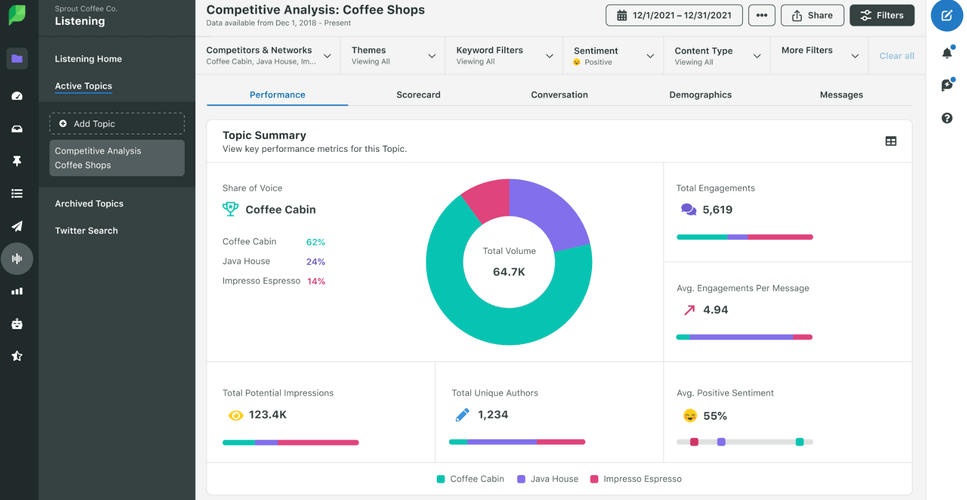
Comparison: Google Alerts vs. Sprout Social
| Category | GA | Sprout Social |
|---|---|---|
| Real-time monitoring | ❌ delayed | ✅ yes |
| Platforms covered | Google only | Social + web |
| Sentiment analysis | ❌ none | ✅ yes |
| Influencer detection | ❌ none | ❌ limited |
| LLM monitoring | ❌ none | ❌ none |
| Noise filtering | ❌ weak | ✅ strong filters |
| Reporting | ❌ none | ✅ advanced analytics |
| Best for | individuals | mid to big businesses, social media teams |
GA collected more total mentions (3,867) than Sprout Social (2,686), largely because it captured significantly more non-social sources.
But Sprout Social shows better sentiment, with 7% positive vs. only 4% for GA, and far fewer bad mentions (1% vs. GA’ 4%).
Sprout also achieved a much higher social media reach (9.3M vs. 1.9M), indicating stronger performance on social channels.

03 Talkwalker & Talkwalker Alerts
Talkwalker offers both a free Google Alerts–style tool (Talkwalker Alerts) and an enterprise-grade listening platform.
Key features (free option):
- Email alerts
- Source filtering
- Custom alert frequency
Key features (Talkwalker Suite – paid option):
- Real-time social listening
- Sentiment analysis
- Trend prediction
- Visual recognition
- Competitor benchmarking
- Automated reporting
Monitored sources:
- Web pages
- Blogs
- Social platforms
- News sites
- Forums
- All major social networks (paid suite)
Best for:
- PR teams (both)
- Large enterprises (paid option)
- Users wanting a free alternative ( the limited free tool option)
Strengths:
- Talkwalker Alerts is a free Google Alerts alternative
- Extensive enterprise features in the paid option
What could be better:
- Big jump in cost from free → enterprise (but same in terms of what it offers)
- Steep learning curve
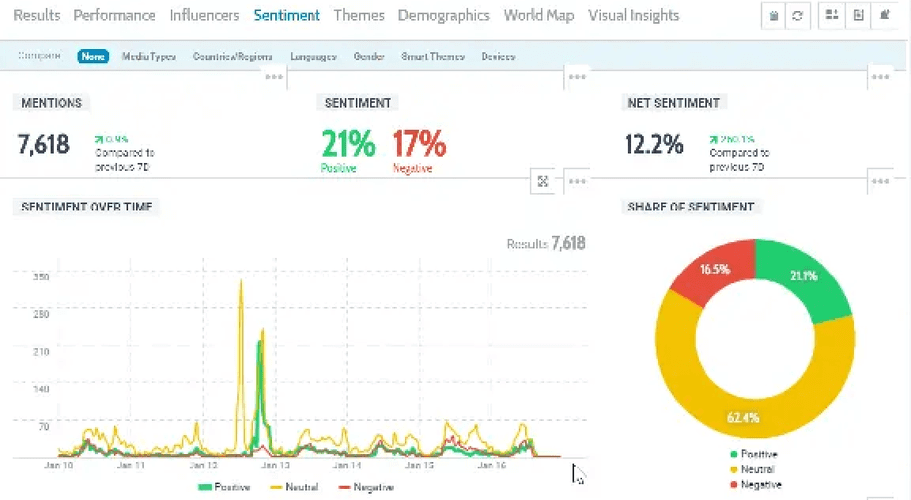
Comparison: Google Alerts vs Talkwalker
| Category | GA | Talkwalker / Talkwalker Alerts |
|---|---|---|
| Real-time monitoring | ❌ delayed | ✅ yes (paid) / near real-time (free) |
| Platforms covered | Google only | Web + some social |
| Sentiment analysis | ❌ none | ✅ yes (paid only) |
| Influencer detection | ❌ none | ✅ yes (paid only) |
| LLM monitoring | ❌ none | ❌ none |
| Noise filtering | ❌ weak | ✅ strong filters |
| Reporting | ❌ none | ✅ automated (paid) |
| Best for | individuals | MEdia relations teams + enterprises |
GA generated significantly more total brand mentions (3,870) than both Talkwalker (826) and Talkwalker Alerts (51), mainly due to its large volume of non-social media sources.
Talkwalker, however, shows a slightly better positive sentiment ratio (5%) compared to GA’s 4%, although it also records a much higher share of negative mentions (8% vs. 4%).

04 Mention
Mention is a listening and media monitoring tool.
It picks up real-time brand mentions across social media, web, news, and reviews, and lets you respond directly inside the app.
Key features:
- Real-time monitoring
- Sentiment analysis
- Influencer identification
- Competitor tracking
- In-app responding
- Statistics + reports
- Publishing & scheduling
- Automated alerts
Monitored sources:
- All major social media platforms
- News
- Blogs
- Forums
- Review sites
- Web pages
Best for:
- SMBs
- Agencies
- Social media managers
- PR teams that want instant responses
Strengths:
- You can respond to mentions inside the platform
- Strong filtering & segmentation
What could be better:
- Historical data is limited in the lower plans
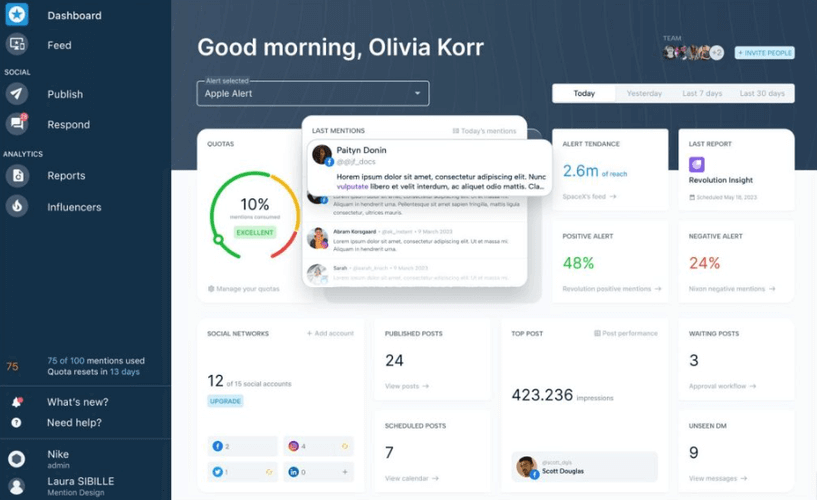
Comparison: Google Alerts vs Mention
| Category | GA | Mention |
|---|---|---|
| Real-time monitoring | ❌ delayed | ✅ yes |
| Platforms covered | Google only | Social + web |
| Sentiment analysis | ❌ none | ✅ yes |
| Influencer detection | ❌ none | ✅ yes |
| LLM monitoring | ❌ none | ❌ none |
| Noise filtering | ❌ weak | ✅ strong |
| Reporting | ❌ none | ✅ statistics + reports |
| Best for | individuals | SMBs + agencies |
Google Alerts captured far more mentions (3,870) than Mention (71).
However, Mention has a stronger positive sentiment, with 8% positive mentions compared to Google Alerts’ 4%, although its sample size is much smaller.
Mention also shows a slightly higher share of negative mentions (5% vs. 4%), but overall delivers a more favorable sentiment ratio.

05 Meltwater
Meltwater is a premium enterprise suite with great source volume: web, social, podcasts, broadcast, print, and more.
If your brand regularly appears in the news, Meltwater is one of the best Google Alerts alternatives you can invest in.
Key features:
- AI-driven media monitoring
- Sentiment analysis
- Trend discovery
- Historical data (15+ months)
- Real-time alerts
- Custom dashboards
- Automated reports
Monitored sources:
- News & media sites
- Web pages
- All major social networks
- Podcasts & video
- Broadcast (TV, radio)
Best for:
- Large brands
- Government organizations
- PR & communications teams
Strengths:
- Widest media coverage
- Full PR management suite
What could be better:
- Pricing is more enterprise-tier – overkill for small teams
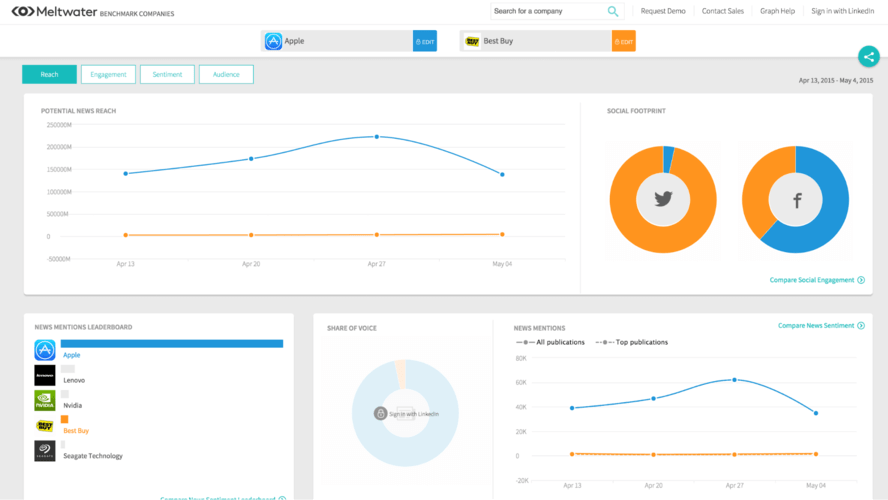
Comparison: Google Alerts vs Meltwater
| Category | GA | Meltwater |
|---|---|---|
| Real-time monitoring | ❌ delayed | ✅ yes |
| Platforms covered | Google only | Omnichannel coverage |
| Sentiment analysis | ❌ none | ✅ yes |
| Influencer detection | ❌ none | ✅ yes |
| LLM monitoring | ❌ none | ❌ none |
| Noise filtering | ❌ weak | ✅ excellent |
| Reporting | ❌ none | ✅ advanced automated reports |
| Best for | individuals | large organizations |
GA collected more total mentions (3,870) than Meltwater (1,154).
Meltwater has significantly stronger sentiment, with 8% positive mentions compared to Google Alerts’ 4% and only 2% negative mentions versus Google Alerts’ 4%.
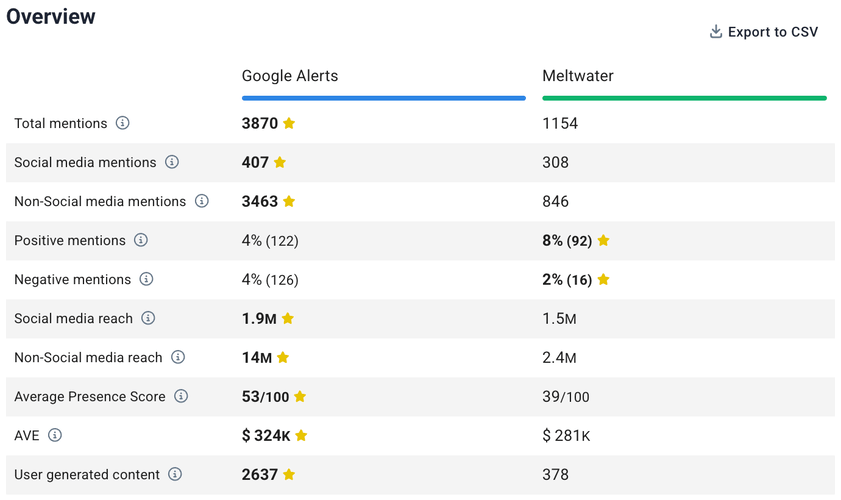
06 Awario
Awario is a social listening platform known for being budget-friendly while still offering strong analytics and real-time tracking.
Key features:
- Real-time monitoring
- Sentiment analysis
- Custom alerts
Monitored sources:
- Social networks
- Blogs
- News sites
- Forums
- Review platforms
- Videos
Best for:
- Startups
- SMBs
- International brands needing multilingual tracking
Strengths:
- Good sentiment analysis
- Great value for price
- Demographic insights included
What could be better:
- Some users admit that the interface is less user-friendly.
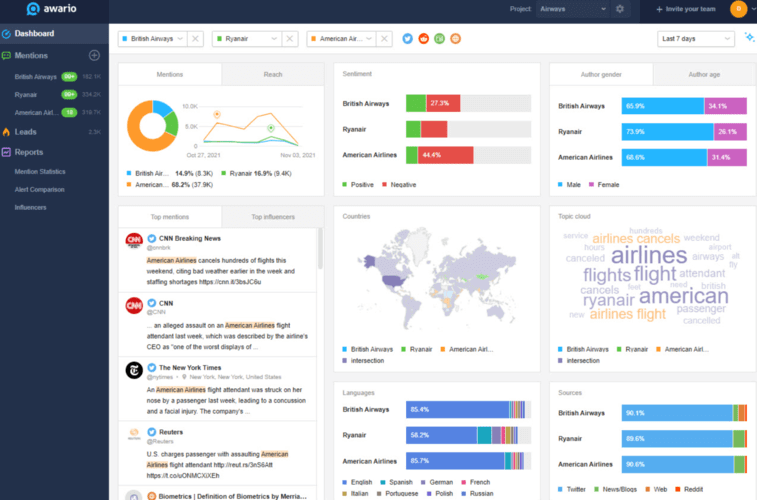
Comparison: Google Alerts vs Awario
| Category | GA | Awario |
|---|---|---|
| Real-time monitoring | ❌ delayed | ✅ yes |
| Platforms covered | Google only | Social + web |
| Sentiment analysis | ❌ none | ✅ yes |
| Influencer detection | ❌ none | ❌ limited |
| LLM monitoring | ❌ none | ❌ none |
| Noise filtering | ❌ weak | ✅ good |
| Reporting | ❌ none | ✅ dashboards + exports |
| Best for | individuals | SMBs + startups |
GA gathered far more mentions overall (3,870) than Awario (65).
Awario has significantly stronger positive sentiment, with 17% positive mentions compared to GA’s 4%.
Awario also shows a slightly higher negative share (7% vs. 4%), but its overall sentiment profile is notably more favorable.
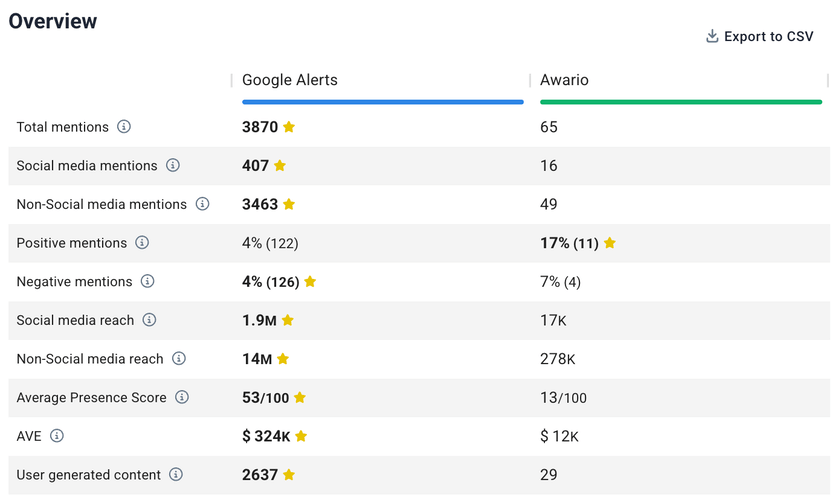
07 Sprinklr
Sprinklr is an enterprise social listening, customer experience, and omnichannel analytics platform.
It’s best known for managing large-scale social operations.
Key features:
- Real-time social listening
- AI-based insights
- Sentiment analysis
- Custom dashboards and automated reporting
- Audience engagement analytics
Monitored sources:
- All major social media platforms
- News sites
- Blogs
- Forums & communities
- Messaging channels (depending on plan)
- (No LLM monitoring)
Best for:
- Enterprise organizations
- Brands needing unified customer intelligence
Strengths:
- Extremely deep analytics and enterprise workflow capabilities
- AI-driven insights help identify trends, risks, and customer needs
What could be better:
- Pricing is enterprise-level and typically too high for smaller teams
- Complex interface and steeper learning curve than most tools
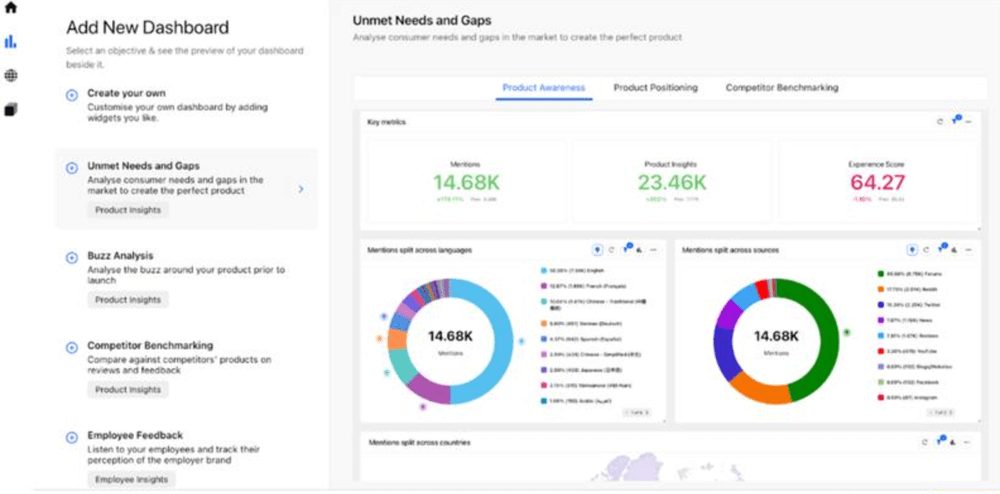
Comparison: Google Alerts vs Sprinklr
| Category | GA | Sprinklr |
|---|---|---|
| Real-time monitoring | ❌ delayed | ✅ yes |
| Platforms covered | Google only | social + web |
| Sentiment analysis | ❌ none | ✅ AI-powered sentiment & emotion analysis |
| Influencer detection | ❌ none | ✅ available in enterprise plans |
| LLM monitoring | ❌ none | ❌ none |
| Noise filtering | ❌ weak | ✅ strong AI-based filtering |
| Reporting | ❌ none | ✅ advanced dashboards & automated reports |
| Best for | individuals | large enterprises, CX teams |
GA collected more total mentions (3,878) than Sprinklr (1,446).
Sprinklr shows a much stronger sentiment profile, with 10% positive mentions compared to GA’ 4%, despite also recording a slightly higher share of negatives (8% vs. 4%).
Sprinklr also outperforms on social channels, achieving a higher social media reach (2.3M vs. 1.9M) and more social media mentions overall.

08 Keyhole
Keyhole is a social-first platform specializing in hashtag tracking, campaign analytics, influencer insights, and social media reporting.
It’s ideal for teams running campaigns on Instagram, TikTok, and X/Twitter.
Key features:
- Monitoring social media
- Influencer score & influencer discovery
- Sentiment analysis
- Publishing + scheduling
Monitored sources:
- TikTok
- X/Twitter
- YouTube
- LinkedIn (partial)
- limited web
Best for:
- Agencies
- Social media teams
- Influencer-heavy brands
- Campaign-driven marketing teams
Strengths:
- Deep influencer insights
- Custom dashboards
What could be better:
- Less web/news monitoring than other tools
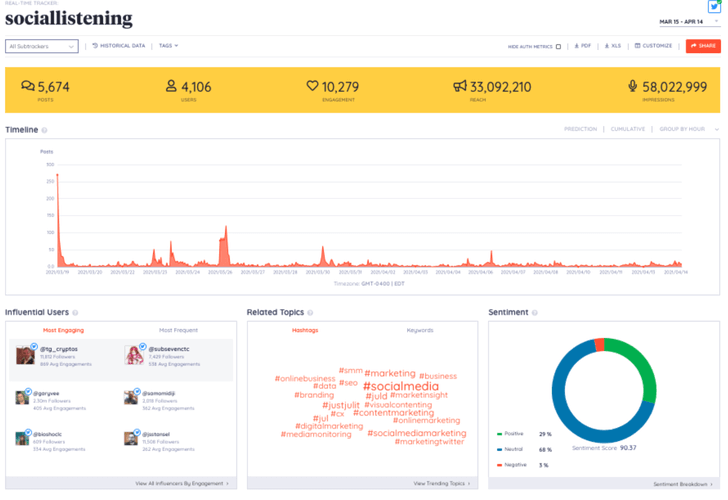
Comparison: Google Alerts vs Keyhole
| Category | GA | Keyhole |
|---|---|---|
| Real-time monitoring | ❌ delayed | ✅ yes |
| Platforms covered | Google only | Social-first |
| Sentiment analysis | ❌ none | ✅ yes |
| Influencer detection | ❌ none | ✅ strong |
| LLM monitoring | ❌ none | ❌ none |
| Noise filtering | ❌ weak | ✅ strong |
| Reporting | ❌ none | ✅ advanced dashboards |
| Best for | individuals | social teams + agencies |
GA collected far more mentions (3,878) than Keyhole (8).
The Keyhole dataset is too small to meaningfully compare sentiment quality against GA.
Still, Keyhole achieved a respectable social media reach of 395K despite the low volume, reflecting its strong focus on social-first data.

Which Google Alerts alternative should you choose?
Here’s the simple breakdown:
- Choose Brand24 if you want:
- AI insights and customizable reports
- Social + web + LLMs coverage
- Sentiment + crisis monitoring
- Choose Sprout Social if you want:
- Publishing + monitoring in one
- Deep engagement analytics
- Choose Talkwalker Alerts if you want:
- A free plan alternative with basic monitoring
- Choose Mention if you want:
- Social listening + in-app responding
- Choose Meltwater if you want:
- Enterprise media intelligence platform
- Choose Awario if you want:
- Affordable sentiment analytics
- Choose Keyhole if you want:
- Hashtag + campaign tracking
- Influencer analytics
Here’s what Phil Pallen, Brand Strategist, says:
FAQ
What is Google Alerts?
Google Alerts is a simple email notification tool that tracks new content indexed in Google Search.
It works for blogs, news sites, and public webpages, but doesn’t monitor social media, sentiment, influencer content, or LLMs.
To this day, many Google Alerts users treat it as a starter tool, but look for alternatives once they need real insights.
Using a social listening tool, I conducted a detailed analysis of the most often mentioned pros and cons of this tool.
Here are the results:
| Category | Pros | Cons |
|---|---|---|
| Cost | Free to use | Hidden opportunity cost, misses important mentions, leading to blind spots |
| Ease of setup | Very simple setup, you can create alerts in minutes with no technical skills | Lacks customization (no advanced filters or source targeting) |
| Monitoring coverage | Covers Google-indexed content | No social media monitoring, LLM monitoring, misses lots of data |
| Usefulness | Works for basic personal or small-brand tracking | Misses many mentions; users report important results never appearing. |
| Workflow integration | Easy email-based workflow | Inbox overload (high volume, repetitive alerts create “overstimulation” and frustration) |
| Data quality | — | Poor accuracy, described by users as “so bad it might as well not exist.” |
| Advanced features | — | No sentiment analysis, no influencer tracking, no competitor analytics |
What are the core features of Google Alerts?
- Keyword-based alert notifications
- Email alerts
- Basic web crawling
- Monitoring blogs, news, and websites
- Simple setup
What are the Google Alerts Pros?
- Free
- Easy to set up
- Good for basic brand or topic monitoring
- Works well for Google News alerts
- Useful for link-building discovery (when media mentions get indexed)
What are the Google Alerts Cons?
- Doesn’t monitor social media
- Cannot measure sentiment
- Cannot detect influencers
- No real-time alerts (delayed)
- Misses many mentions + irrelevant results
Because of this, most businesses look for a more powerful alternative.
What sources does Google Alerts monitor?
- News sites
- Blogs
- Public websites
- Google-indexed pages
Is Google Alerts cost-effective?
Google Alerts is free, has no paid plans, no trial, and no advanced features. But the real cost is the data you’re missing, especially:
- social media monitoring
- brand sentiment
- crisis alerts
- industry trends
- competitor analysis



